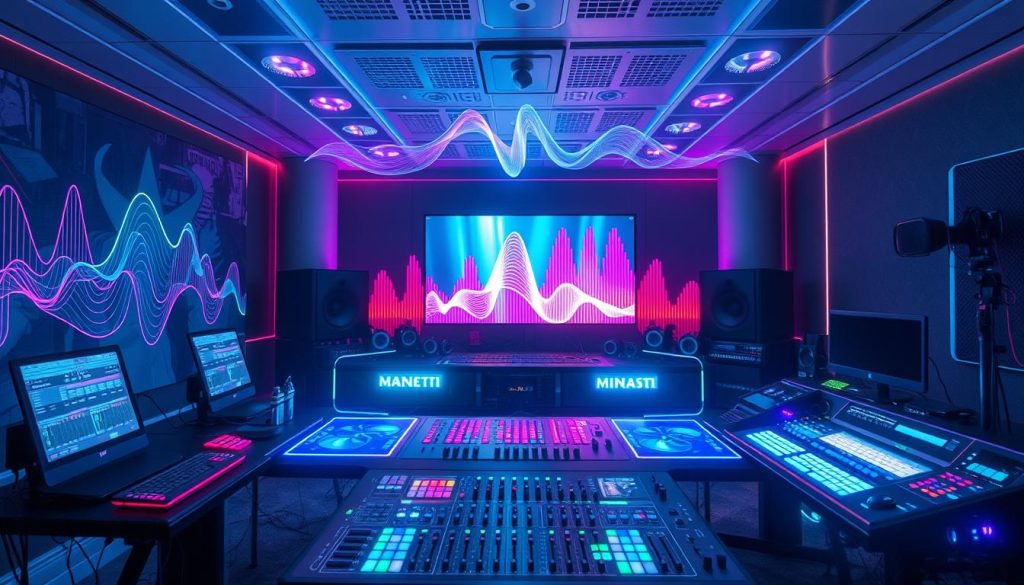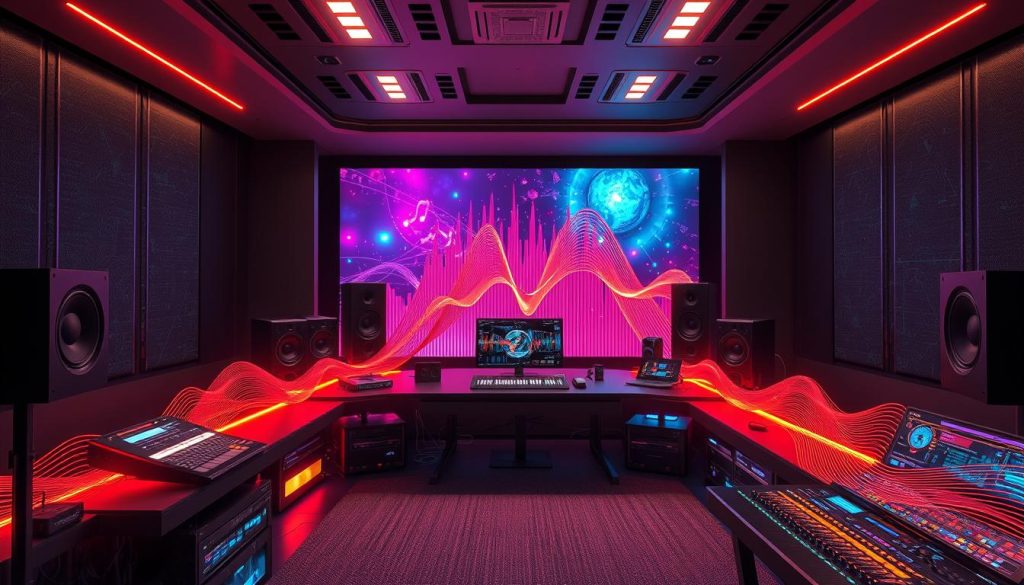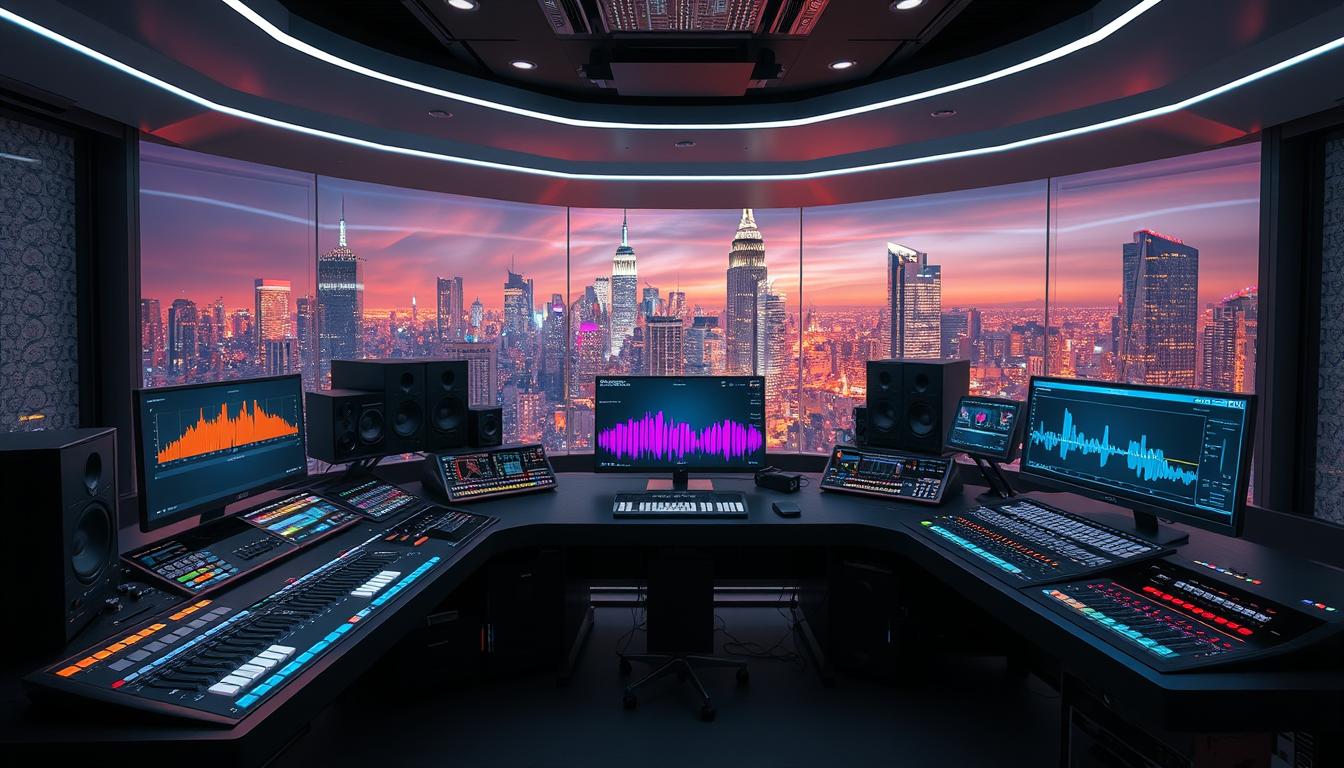I’m excited to see how the audio industry is changing fast. New technologies and fresh ideas are leading this change. Now, audio engineering goes beyond old recording studios. It’s now a mix of new, immersive, and AI-powered ways to make, listen to, and feel sound.
Virtual sound engineering is at the heart of this change. It’s making audio production more exciting. With spatial and immersive audio, we can take listeners to new sound worlds. This mixes reality with imagination in a cool way.
Exploring virtual sound engineering, I see huge potential to change the audio world. AI is making music production better, and new audio formats are improving. Let’s dive into these new trends. We’ll see how virtual sound engineering is changing audio production for the better.
The Rise of Immersive Audio Experiences
The world of audio is changing fast, thanks to new tech like spatial audio. This tech lets us make sounds that seem to come from all around us, not just left and right. It’s like stepping into a movie where sounds move around you.
Spatial Audio: Redefining How We Experience Sound
This new tech is a big deal for virtual and augmented reality. It makes you feel like you’re really there. Apple’s AirPods use it to make music feel more real. Gamers love it too, as it makes games more exciting.
Immersive audio, spatial audio, and 3D audio are changing how we hear things. They’re making games and virtual worlds more real. As more people want to dive into virtual reality, the role of gaming audio will grow too.
Artificial Intelligence: The Game-Changer in Music Production
AI and machine learning are changing music production. They help audio engineers and composers work better and be more creative. This leads to new sounds and possibilities in music.
AIVA is a great example of AI’s effect on music. It uses machine learning to make new music. AIVA learns from a lot of classical music. This lets it make music that fits certain moods or styles.
AI is changing how music is made. It does some tasks automatically, making mixing and mastering easier. This lets music makers focus on being creative. AI helps make music better and faster.
We’ll see more AI tools in music production as time goes on. The future of music is linked to AI. It promises a new era of creativity and innovation in music.
Virtual Sound Engineering: Pushing the Boundaries of Audio

I love being an audio engineer and seeing how much virtual sound engineering has grown. It’s changing fast because of better computers and new audio plugins. These changes are making how we make and change sound totally new.
Audio plugins add special features to audio systems. Now, they can do a lot more. We can make sounds like old equipment, create complex sounds, and even use AI for mixing and mastering. This makes making great audio easy for more people, from beginners to pros.
Computers are getting more powerful, which means we can do more with audio in real-time. Engineers can work on more tracks, use more plugins, and handle better quality audio without problems. This lets us do amazing things in virtual sound engineering, always making new things possible.
- Sophisticated audio plugins emulate vintage hardware and create complex soundscapes
- Artificial intelligence assists in mixing and mastering, enhancing the audio engineer’s workflow
- Increased computing power enables real-time processing of higher track counts and higher-resolution audio formats
I’m really excited to see where virtual sound engineering goes from here. It’s making making music easier for everyone. It’s letting a new generation of creators try new things in the world of sound.
High-Resolution Audio: Elevating the Listening Experience

Music lovers want a deeper connection with their tunes. High-resolution audio has changed the game, offering a new way to hear music. Formats like FLAC and MQA make songs clearer and more detailed.
Redefining Audio Quality with High-Resolution Formats
High-resolution audio has a higher sampling rate and bit depth. This means it captures more of the original sound. Listeners get a wider range of sounds, richer tones, and a bigger soundstage.
This shift has changed how music lovers hear their favorite songs. It’s like hearing music for the first time. Audio engineers now focus on high-resolution audio to meet listener demands.
The push for better audio quality is driving innovation in the industry. New technologies are being developed to enhance sound. The future is bright for high-resolution audio, and those who follow it will lead in music listening.
The Future of Collaboration: Remote Audio Production
The world is getting more connected, and so is the audio engineering world. The COVID-19 pandemic made us all use cloud-based audio and low-latency streaming more. Now, musicians, sound engineers, and producers can work together from anywhere.
These new tools in remote audio production have changed how we make music. I can now join projects and meet new people, thanks to virtual collaboration tools. Cloud-based platforms let me share audio files instantly. This means I can get feedback and make changes right away, just like being in the same room.
I think working remotely will be key for audio pros in the future. The music industry is changing fast. It will need people who can adapt and use new tech. By using these tools, I can keep up with the industry. I can work with great artists and engineers worldwide, making new music together.

